Johnson Celebrates Diversity and Inclusion with Pride
2178.png?generation=1687931053605514)
NASA’s Johnson Space Center recognizes diversity and inclusion as essential strengths. To mark Pride Month in June, Johnson recognizes the LGBTQI+ workforce as a shining example of what can be achieved when employees are celebrated for their uniqueness and free to be themselves.
LGBTQI+ Pride Month is held annually to promote the self-affirmation, dignity, equality, and increased visibility of lesbian, gay, bisexual, transgender, and queer people as a social group. The spirit of Pride intersects with NASA's dedication to breaking down barriers and inspiring a future of hope. At NASA, we focus on unity provided by a common purpose: pioneering the future of space exploration, scientific discovery, and aeronautics research.
Read below about the trailblazing LGBTQI+ people of Johnson who make outstanding contributions to human spaceflight.
***
Will Davis, Diversity, Equity, and Inclusion Program Manager
Davis began his career as an engineer overseeing safety and quality control for projects and programs such as the International Space Station and Orion. He believes that understanding the “engineer's perspective” is critical to working with people and achieving his goals of cultural inclusion. Now, Davis combines his love of STEM and people to ensure everyone feels heard and included.
Davis has been instrumental in leading process improvements to foster integrated staff activities by what he calls a “community of practice approach.” Additionally, he has worked to establish 10 employee resource groups (ERG) at Johnson that include NASA’s minority populations.
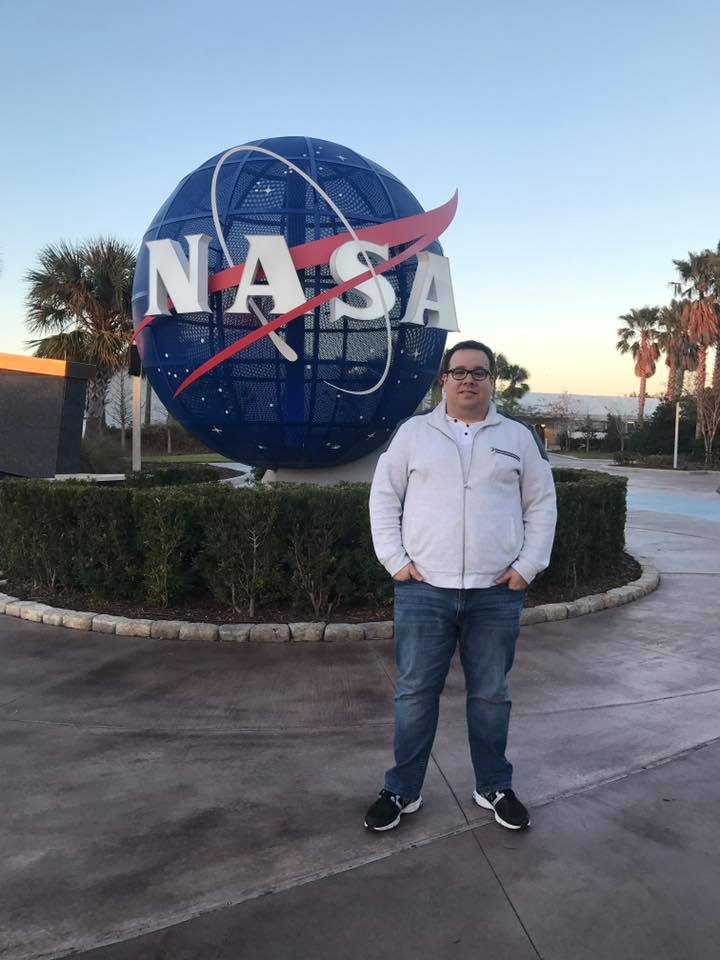
Will Davis at NASA’s Kennedy Space Center visitor complex.
“The most rewarding part of my job is bringing people together to be their individual best, so we as a NASA workforce can be our collective best and make good on our mission to explore space for the benefit of all humanity,” he said. “What we do isn't possible without people. They propel us forward.”
Davis believes that NASA can support and empower the LGBTQI+ community by continuing to update policies, procedures, and practices that promote the inclusion of all individuals. He maintains a growth mindset to push the frontier of what's possible.
A person who nominated Davis says, “Will is always willing to answer questions patiently, and I've learned so much from him during my journey as an LGBTQI+ ally. He is the backbone of Out & Allied ERG.”
Davis has been a champion of diversity and inclusion at NASA for many years. He firmly believes that LGBTQI+ individuals have the same hopes, needs, and desires as any other human, and there's no need to "other" the community. He understands that the words people choose, the behaviors they exhibit, and the actions they take can all build connection. Davis is determined to keep striving for better inclusion and acceptance.
Davis also recognizes that the greatest challenges facing the LGBTQI+ community are coming from the outside. The state of the country, cultural disagreements, and media and legislative landscape are all making the world seem less welcoming for LGBTQI+ folks. This impacts their feeling of belonging and safety. Davis believes that we need to take conscious steps to support each other and create a more inclusive environment.
“It matters to those struggling to embrace your identity and live your life authentically,” he said. Davis advises the LGBTQI+ community to continue being visible to the fullest extent possible, safely.
“I hope to pass on to the next generation that through our collaboration with others, anything is possible,” he said. “Getting to the Moon and onward to Mars will take all of us working together.” Davis is committed to making sure everyone is included and represented in that journey.
***
Chasity Williams, Exchange Operations Manager, Starport
Williams leads a dedicated team tasked with providing employee engagement and morale-boosting activities designed to engage, enrich, and energize the Johnson workforce. She is a passionate leader at NASA who loves working with her awesome, hard-working team. “This role allows me to live my passion five days a week,” she said. “It’s a pretty cool job - even with the challenges.”
Starport provides a unique capability at Johnson that most federal agencies do not have access to. Williams explains that it's like running a small, highly regulated business that is not about driving profits but isn't a nonprofit either. Her team has to make just enough income to be self-sustaining.
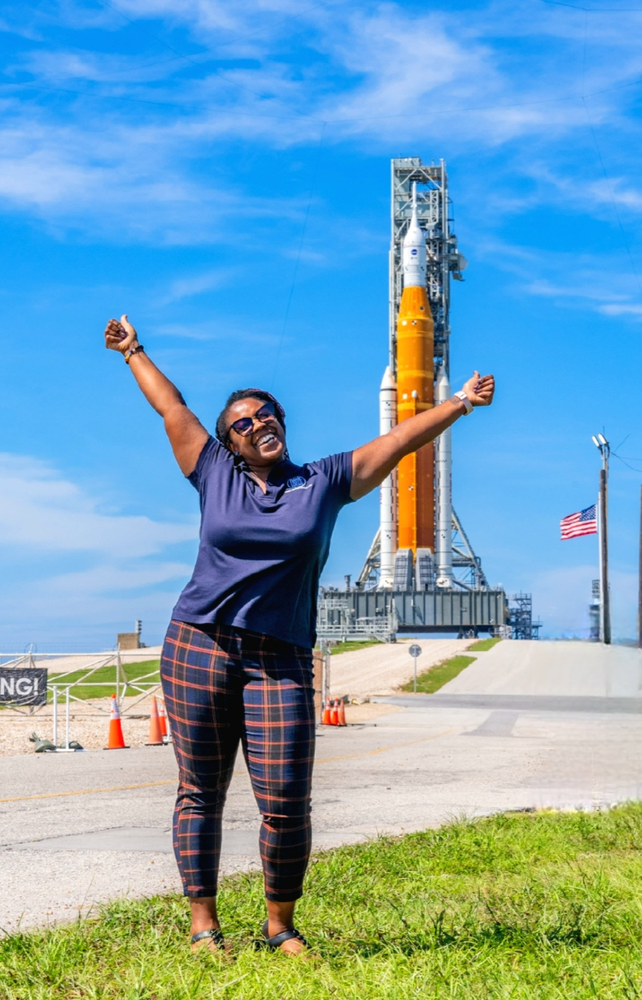
Chasity Williams in front of NASA’s Orion spacecraft atop the Space Launch System rocket at Kennedy Space Center.
With a passion for building connections, Williams enjoys the challenge of knocking down barriers that make it difficult to provide services that benefit Johnson employees. She gets to lead team engagement activities that help nurture Johnson's culture and contribute to employees' personal and professional goals. Williams coaches a team of employees that make it all happen.
Williams’ colleagues have praised her leadership skills and ability to lead Out & Allied ERG during COVID and workforce changes. “Chasity has done an amazing job leading the ERG back to growth. She has been outstanding at getting members to participate, always being available and encouraging, and just an overall strong ERG chair,” said a person who nominated her.
Williams believes that NASA can better support and empower the LGBTQI+ workforce by fostering spaces for people to connect authentically and enjoy each other's company. She thinks encouraging employees at every level to support diversity, equity, inclusion, and accessibility (DEIA) activities is crucial. She also believes that speaking out against behaviors and rhetoric that do not support DEIA efforts is essential.
Williams states that the most significant challenges facing the LGBTQI+ community today are educating people on the importance of supporting the transgender community and creating a safe environment where people can be themselves. She advises members of the LGBTQI+ community to reach out to their support systems, whether it’s a friend, coworker, community leader, distant relative, or even a stranger they have a connection with.
As a member of the LGBTQI+ community, Williams has encountered her own set of challenges. It was in the late 2000s when she came out. At that point, Williams had two kids and had been married to her now ex-husband for 22 years. “I felt very alone because I didn’t know how anyone who had gone through something like this,” she said. “I was able to connect with a member of the Out & Allied ERG who had experienced something similar. It made a world of difference.”
Williams found that having ERGs that cater to a particular affinity allowed her to access the support she was desperately seeking. “You are never alone,” she said. “Dream big! Do big things! Live beyond limitations!”
***
Kate Suratt, Project Planning and Control Lead, EVA Development Project
Suratt is an integral member of NASA’s EVA and Human Surface Mobility Program. While her work is primarily focused on the new spacesuit development efforts for Artemis missions, she is also driven to learn more about the program’s hardware and operations.
Last summer, Suratt volunteered for the Exploration Atmosphere Prebreathe Validation study, which involved living in a reduced-pressure environment for 11 days, completing a series of five simulated spacewalks, and assessing a potential astronaut food system. This study evaluated alternative prebreathe protocols crew members can undertake before future planetary EVA operations. "I learned so much from the research and test teams,” she said. “I’m so proud of that effort and appreciate the opportunity to broaden my understanding of our facilities and mission.”
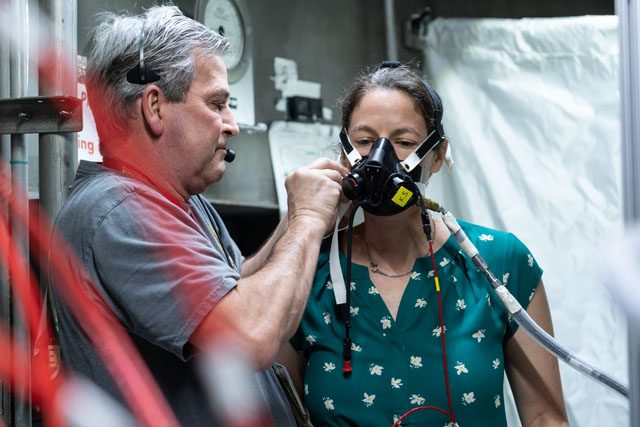
A Crew and Thermal Systems Division test team member at Johnson assists Kate Suratt with mask fit prior to the Exploration Atmosphere Prebreathe Validation study in June 2022.
Suratt is also committed to empowering her fellow LGBTQI+ colleagues. She was the chair of Out & Allied ERG from 2019 to 2020 and played an active role in its success. Suratt believes that maintaining agency support for ERGs and showcasing diversity and inclusion will contribute to recruiting and retaining the most diverse and representative employees.
“At NASA, we have the advantage of a uniting mission that gives us passion and purpose,” she said. “It ultimately provides us with common ground to build relationships and trust.”
Suratt's colleagues admire her commitment to inclusivity and her efforts to make the workplace more accepting for everyone. “Kate is a visible leader in the LGBTQI+ community at JSC,” wrote an individual who nominated her. “By being willing to share her story, she has inspired others to be out at work and be true to themselves. I admire her honesty and openness.”
Suratt's two most positive experiences as a member of the LGBTQI+ community were walking with NASA in the Pride Parade and attending the Out & Equal Workplace Summit in Washington, D.C.
She believes building a community is a great way to find supportive friends and coworkers. “I try to stay engaged and visible,” she said. "Consider being a role model if it's safe, and let's keep moving forward. The future is bright and love always wins.”
Suratt's hope for the future is to pass on to the Artemis Generation a robust lunar architecture to build on and the understanding that space is for everyone. Her hope is the next generation can find their place in space and feel safe to be themselves.
***
Lisa Shore, Deputy Chief, Neutral Buoyancy Laboratory
Shore, a NASA engineer at the Neutral Buoyancy Laboratory, is passionate about improving the training environment that supports Artemis and new spacesuit development. “I love being relevant and making a difference in NASA’s mission,” Shore said.
Shore believes that NASA can continue to empower the LGBTQI+ workforce by growing and showing support from the top down. “Having your center director and other high-level people march in the Pride Parade with us goes a long way toward showing that we are an accepted and integral part of the NASA workforce,” she said. “The creation of the Out & Allied ERG and the visibility that provided was a huge step forward.”
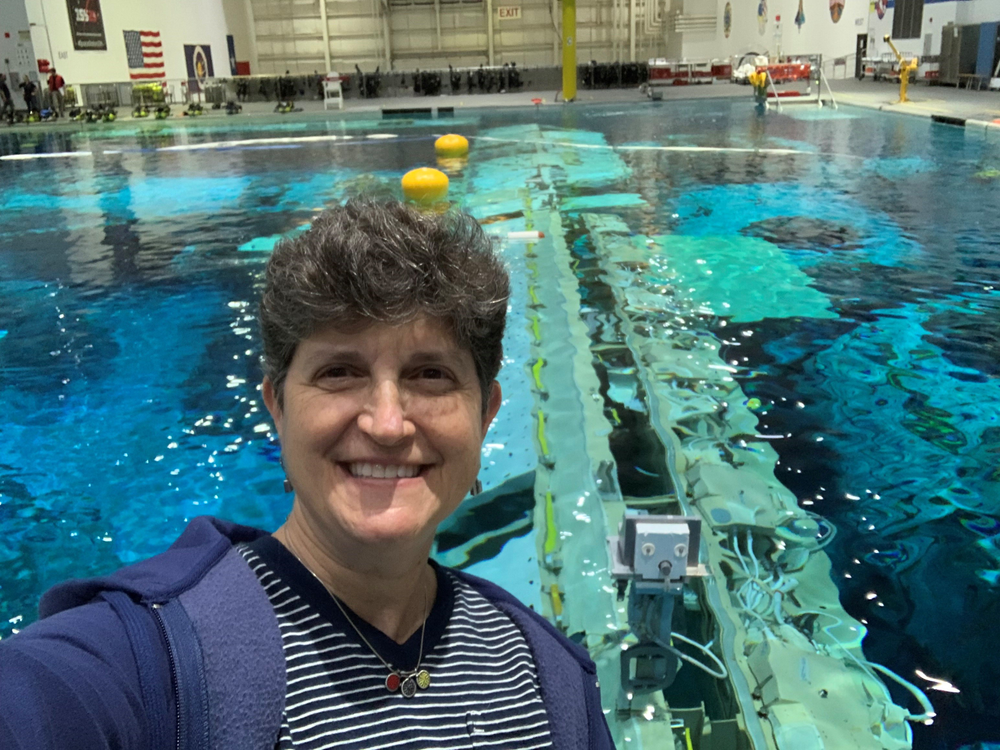
Lisa Shore at the Neutral Buoyancy Laboratory (NBL), an astronaut training facility complete with a mock-up of the International Space Station. NBL is operated by NASA and located at the Sonny Carter Training Facility.
Shore's commitment to normalizing the LGBTQI+ community at NASA has earned her admiration from her colleagues. One person who nominated her said that she helped initiate a lot of changes that have made Johnson a more inclusive workplace. Shore's advice to the LGBTQI+ community is to live how you want to be viewed and treated, be proud, and not hide who you are to make other people comfortable.
Shore acknowledges that while it seems to be socially acceptable to be LGBTQI+ now, we still have a long way to go toward legal protection against discrimination. She hopes to pass on to the Artemis Generation all the progress made toward full acceptance in the workplace so that the next generation doesn't have a moment's hesitation about bringing their full selves to work. "Spaceflight is difficult and there is no substitute for hard work and always being prepared, but the personal reward and pride that you feel is like nothing else in the world," she said.
Shore's dedication to improving NASA's training environment and normalizing the LGBTQI+ community serves as an inspiration to others at NASA and beyond.
***
David Baumann, Director, Human Research Program
Baumann plays a crucial role in NASA's Human Research Program, which provides human health and performance countermeasures, knowledge, technologies, and tools to enable safe, reliable, and productive human space exploration. For Baumann, the most rewarding part of his job is working with a talented and motivated team focused on keeping crews healthy and thriving during spaceflight missions.
“One of the best parts of working at NASA is the support shown throughout the organization for its diverse workforce,” Baumann said. He appreciates the recognition of different affinity groups throughout the year and believes in the agency’s ongoing efforts to ensure everyone can bring their true and full selves to work.
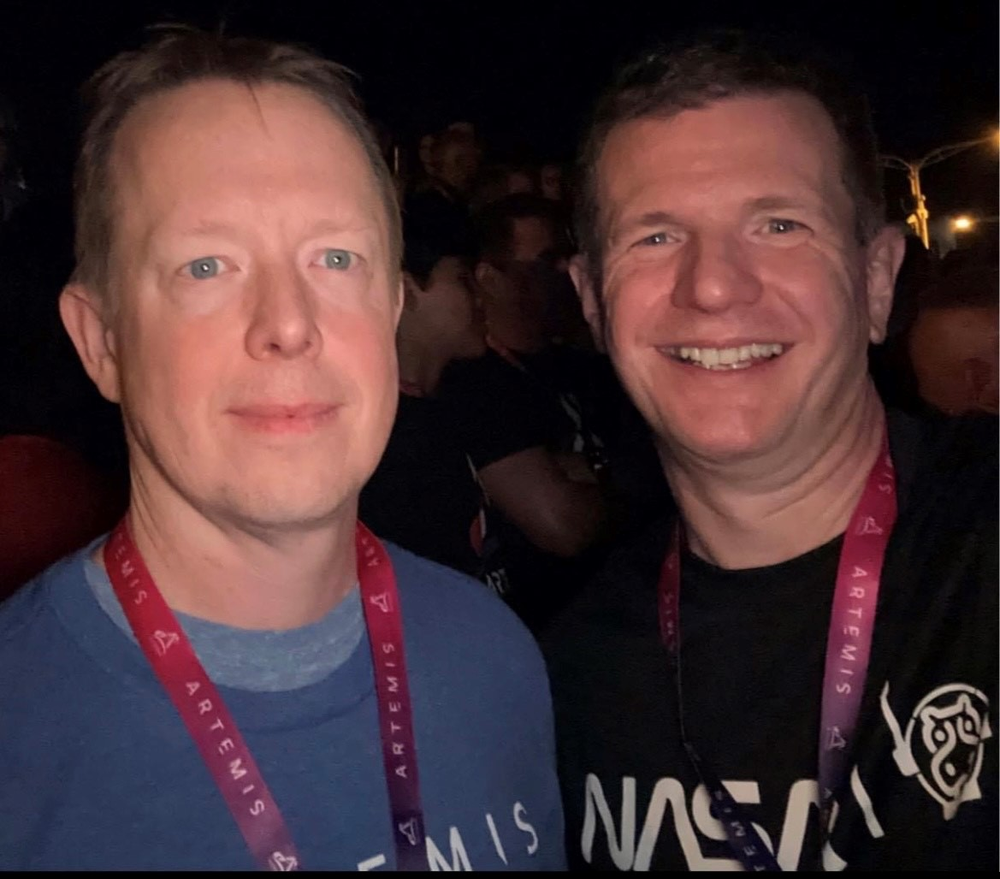
David Baumann (left) and his husband at the Artemis I launch.
As for progress regarding LGBTQI+ rights and representation, Baumann was pleasantly surprised when he was legally able to marry his husband in 2016 after dating for over a decade. "I wasn't sure that would ever happen in my lifetime, so that's been pretty great," he said.
Baumann's colleagues admire him for being a great leader and a great example to the LGBTQI+ community. Before coming out in the early 2000s, he received feedback to “be his true self” at work and give others the opportunity to accept who he is. Since coming out to his coworkers, Baumann has appreciated the support and acceptance shown by the NASA community and has found that being authentic at work has been nothing but positive.
Baumann hopes to pass on to the Artemis Generation a NASA culture that continues to benefit from the strengths of its diverse workforce and ensures that going forward, space is for everyone.
***
Zachary Taylor, Senior Space Architect, Center for Design and Space Architecture
Taylor is a designer for a team that helps develop human-rated habitats in extreme environments. He is currently working on developing the interior of Gateway's habitation and logistics outpost module. For Taylor, the most exciting part of his job is the opportunity to reconceptualize how things should be designed and constructed based on centuries of precedent, and how he can incorporate lighting and color to enhance the crew experience.
“It’s exciting to reconceptualize how a bed, a handrail, or a cockpit panel should look, function, and feel,” Taylor said. “It’s a near-blank slate, and one that offers an immense amount of challenge and creativity.”
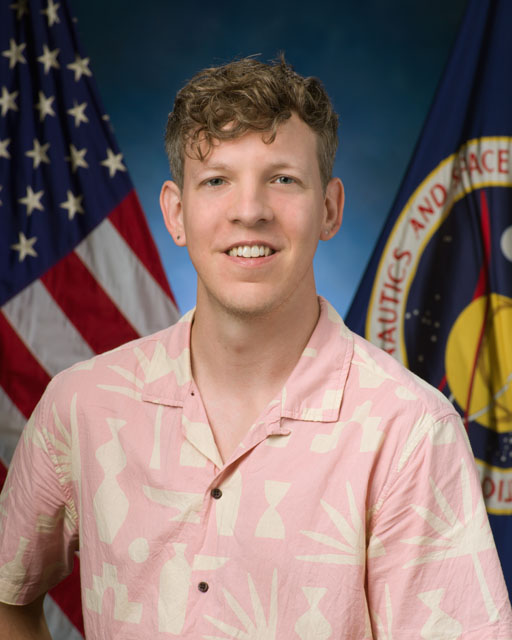
Official NASA portrait of Zachary Taylor. Credit: NASA
When it comes to STEM engagement and outreach, Taylor appreciates that "STEAM" represents STEM plus the arts. Taylor went to an art and design university and never thought there would be a role for him in aerospace until very late in his education. He strongly believes that interdisciplinary STEAM innovations will be key to solving complex current and future problems in space.
“I’m lucky to currently work for both a group and an organization that values diversity in skill and thought,” he said. “The Out & Allied ERG here at NASA has been a great way for me to connect with the vibrant LGBTQI+ community at Johnson.”
Taylor is aware of the challenges facing the LGBTQI+ community, and he wants them to have hope. “You are not alone, and the future is on your side,” he said. "It’s important to seek fulfillment and expression outside of work.”
“There is so much potential that the future of space offers,” he added. "Always be suspicious whenever you hear the phrase 'it is what it is.' That is not how we got through Apollo, and it will not be how we get through Artemis.” With Taylor's passion and dedication, he will continue to push the boundaries of art and design in aerospace and inspire others to embrace STEAM and diverse thinking to solve complex problems in space.
***
Steven Riley, Deputy Chief of the Space Vehicle Mockup Facility
Riley manages the flight operations portion of Building 9 where astronauts, flight controllers, and instructors are trained in full-size mockups of International Space Station and Artemis vehicles.
What Riley loves most about his job is the people that make it a fun workplace. He commends the team for keeping the facility running smoothly, managing mockups, completing upgrade projects, and interfacing with users.
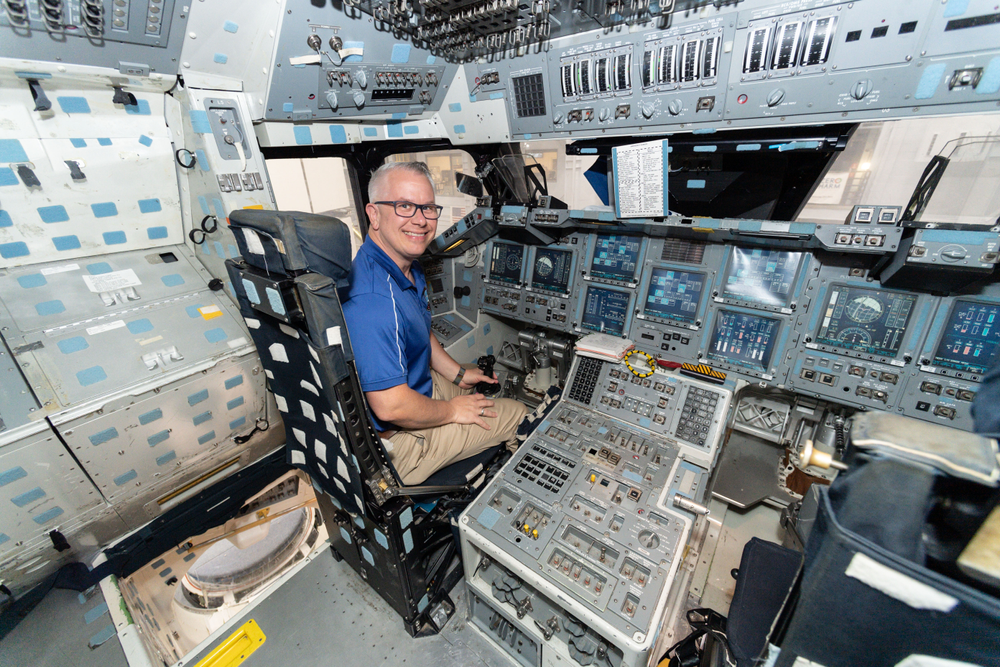
Riley highlights NASA's invaluable support through various employee resource groups, especially benefiting newer employees by fostering inclusivity and visibility. He encourages employees in the LGBTQI+ community to get involved in Out & Allied ERG. “It's a terrific organization for socialization and support and will help you to build your network of allies,” he said. “NASA has made great strides over the last decade in terms of support for our workforce, well beyond any expectations I had in my lifetime.”
Riley advises the Artemis Generation to be unapologetically authentic. “It is important to bring your whole self to work – and we need you to accomplish the mission without the distraction of worrying about hiding who you are,” he said. Riley hopes the next generation recognizes that their voice matters and can be used to change the world for the better.







